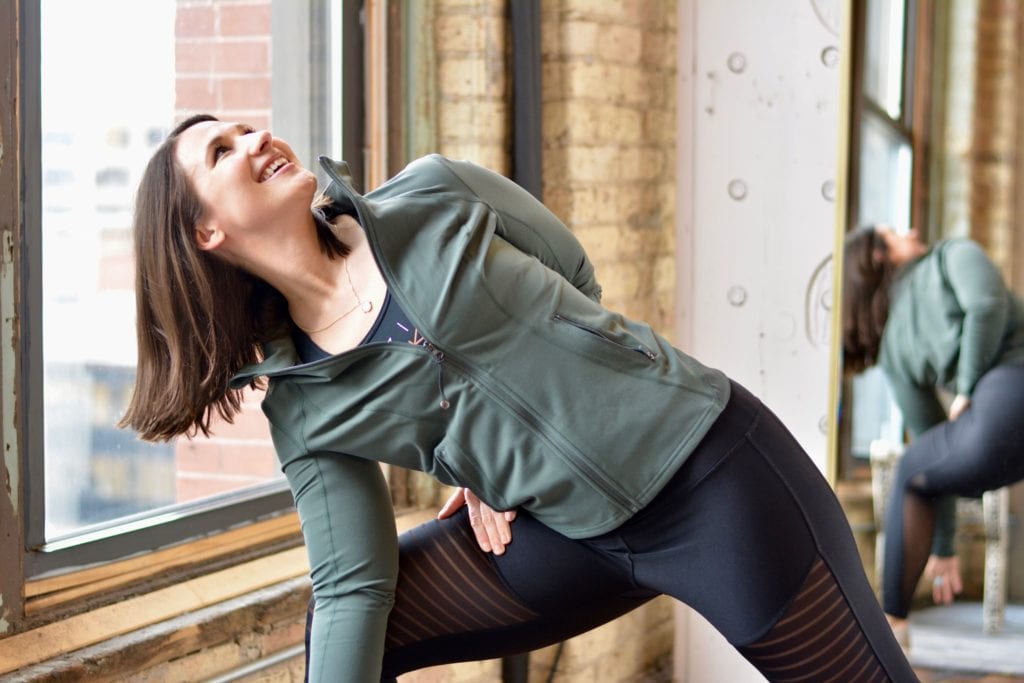Shoulder Flossing: What It Is and Why You Should Do It
Like most people, I hold a lot of tension in my neck, shoulders and upper back. Between daily workouts, sitting at a computer all day and almost always generally being cold, I find my shoulders are tense more often times than they are relaxed. Does anyone else ever find their shoulders so tight they are pretty much touching your ear lobes? Yep, that’s me like every day. That is until I discovered shoulder flossing.

What is shoulder flossing?
Shoulder flossing is a stretching move I first discovered at a restorative yoga class one Sunday afternoon that involves sitting down or standing up with a yoga strap. You can also use a longer resistance band, a belt, scarf, tie or towel.
Grab the yoga strap with each hand. Make sure you have a wide grip so your hands are wider than your shoulders. As you start to shoulder floss more, you should be able to narrow your grip, but like anything new, it will take time, especially if your shoulders are really tight.
Lift the yoga strap over your head and back behind your neck down your back towards your tailbone. After holding for a few moments, bring the strap back up and over your head all the way to the front of your body. If you need more visual guidance, please direct your attention to this nifty little YouTube video.
If you plan on trying shoulder flossing for yourself, Kenna Johnson, Cofounder/Trainer at Total Sona Fitness recommends a tip from teaching multiple yoga classes.
“I have seen yogis compensate and round their upper back to get full range of motion for their arms,” she explains. “Instead, as opposed to rounding your upper back, you should focus on keeping your chest open as you bring your arms around. Modify as needed, and keep the top of your shoulder facing the ceiling to get the most out of this wonderful exercise!”
It may sound silly, but think of how you floss your pearly whites. Think of your body as the tooth and the yoga strap as the floss that you are moving in back of you and in front of you to loosen up all of that extra tension built up from the day.
Why should I shoulder floss?
Just like flossing your teeth removes all the excess “ick” from the day, the same goes for shoulder flossing. Shoulder flossing clears any tension in your back, neck and shoulders that has accumulated from a day of typing and texting. Johnson says, “Shoulder and neck pain are increasingly more common due to the role that tech devices play in our daily lives. Opening up the anterior muscles of the shoulder girdle with shoulder flossing is a great way to rejuvenate our posture.”
Maggie Umberger, yoga teacher, personal trainer and fitness instructor based in Chicago, says, “The more I learned about the complexity of the shoulder joint, the more I realized how important it was for me, as a yoga teacher, to offer a variety of sequences set up to move the shoulder joint in all necessary ranges of motion. The shoulder is meant to elevate, depress, protract, retract, internally rotate and externally rotate, but we definitely tend to favor some movements over others.”
Our bodies are incredible, she continues, and they’re made to move in so many ways. That said, the “use it or lose it” principle applies here: if you don’t practice mobility, you may be doomed to lose it.
Shoulder flossing is a technique that truly moves the shoulders in all directions: back, down, front and up. It’s non-linear and you are able to get the entire joint moving. Don’t you feel more relaxed already? The next time you floss your teeth, grab your yoga strap and floss your shoulders too!
1 thought on “Shoulder Flossing: What It Is and Why You Should Do It”
Comments are closed.













Maybe I should try this one! My shoulder, neck and back usually ache but I just aid it with hot bath but this could be a good solution too!